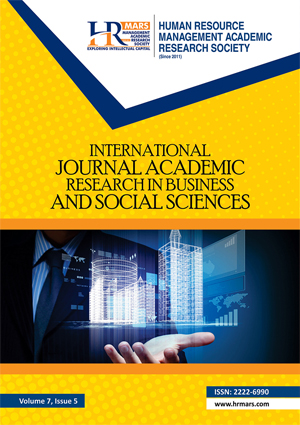
ISSN: 2222-6990
Open access
Importance: The importance of the study lies in the possibility of customs leaders benefiting from the scientific outputs of the hypothetical model of the study, and that these outputs contribute, through the results and recommendations reached, to improving the response, excellence in performance, sustainability, and excellence in the services provided by Jordanian Customs. The importance of the study also stems from the importance of the sector in which it will be applied, which is considered one of the main sectors and one of the most important pillars of the national economy due to its vital role in protecting and monitoring trade and reducing economic violations. Purpose: This study investigates the impact of talent management (attracting talents, developing talents, retaining talents, and managing talent performance) on smart organization within Jordan Customs. Methodology: It is considered applied in terms of nature, and explanatory in terms of purpose, this research involved 85 employee in Jordan Customs. Findings: We accept hypothesis, which states that talent management exists in its dimensions (talent attraction, talent development, talent performance management) in the smart organization at Jordanian Customs. This result can be attributed to the ability of the Jordanian Customs Department to attract, develop, and manage talented individuals in a manner that achieves its planned objectives. Recommendations: The need to focus on better talent management to improve individual and institutional performance by attracting, retaining, training, developing, and managing talent, and Working to improve and develop the work environment and climate to enable the department to retain talent and meet and support the requirements for innovation and creativity ,the need to focus on the concept of a smart organization within the Jordanian Customs Department and benefit from the experiences of leading countries in this field to enhance the dimensions of a smart organization Conducting similar studies in other departments across the country to benefit from their findings and disseminate their recommendations.
Fatima, B. (2018). The Contribution of Talent Management to Achieving Organizational Effectiveness. Journal of Business Administration and Economic Studies, (7), 131-139.
Saeed, B., Saeed, F. A. (2020). Organizational Agility: A Contemporary Vision for Improving Administrative Work. Dar Al-Hamed for Publishing and Distribution.
Zakia, M., and Naima, H. (2014). The Impact of Talent Management on Organizational Performance through Organizational Commitment: A Field Study at the National Juice and Canned Food Corporation. Journal of Administrative Studies, 7(13), 170-195.
Armstrong, M. (2009).Strategic human resource management: A guide to action (4ed). Kogan Page, Great Britan, Cambridge University Press.
Ashton, C., Morton, L. (2005).Managing talent for competitive advantage. Strategic HR Review , 4(5), 28-31.
Bernadette, S., & Sheetal, R. (2008).Talent management in hospitality: Garduate career success and strategies. International Journal of Contemporary Hospitality Management, 20(7), 781-791.
Cappelli, P. (2008).Talent management for the twenty-first Century. Harvard Business Review , 86(3), 74-81.
Daft, R. L. (2000).Management (5ed). The Dryden Press. Harcourt Collage Publishers.
De Cenzo, D., Robbins, S., & Verhulst, L. (2015).Fundamentals of human resource management (11ed). John Wiley & Sons Inc.
Harte, C., Fitzpatrick, K., Strybosch, V., & Fujimoto, Y. (2007).Human resource management : Transforming theory into innovative practice. Pearson Prentice Hall.
Holden, N., & Viaman, V. (2013).Talent management in russia: Not so much war for talent as wariness of talent. Critical Perspective on International Business , 9(1/2), 129-146.
Matheson, D., & Matheson, J. E. (1998).The smart organization: Creating value through strategic r&d. Harvard Business School Press.
Matheson, D., & Matheson, J. (2016).The smart organization creating value through strategic r&d (2ed).SmartOrg,Inc.
McKenna, E., & Beech, N. (2008).Human resource manangement: A concise analysis(2ed). Financial Times Prentice Hall.
Mendez, A., & Stander, M. (2011).Positive Organization ,the role of leader behavior in work engagement and retention. South Africa Journal of Industry Psychology , 37(1), 46-61.
Osinga, S. (2009).Talent management &oracle hcm. Hcm 3 Groups, Thought Leader Oracle and Hcm Consultancy.
Qui, W., & Bai, A. (2013).Talent show: Training workers for a high-tech world. Human Resource Management: International Digest, 21(3), 22-25.
Silzer, R., &Dowell, B. E. (2010).Strategy-driven talent management (1ed).John Wiley & Sons,Inc.
Tarique, A., & Schuler, R. S. (2010).Global talent management: Literature review, integrative framework, and suggestions for further Research. Journal of Word Business , 45(2), 122-133.
Venkateswaran, N. (2012).Strategies for adopting talent management issues in software companies. International Journal of Management: Economics and Social Scinces , 1(2), 33-41.
Wheelen, T. L., Hunger, J. D., Hoffman, A. N., &Bamford, C. E. (2018).Strategic management and business policy: Globalization, innovation, and sustainability(15ed).Pearson.
Williams, R. V. (1997).Information management for the intelligent organization: The art of scanning the environment. Journal of Academic Librarianship , 23(2), 146-147.
Xin, C., David, P., & Paul, I. (2008).Is talent management just old wine in new bottles?: The case of multinational companies in Beijing. Management Research News , 31(12), 901-911.
AL-Qaraleh, Q. K. M. (2025). The Impact of Talent Management on Smart Organization at Jordan Customs. International Journal of Academic Research in Business and Social Sciences, 15(4), 1213–1231.
Copyright: © 2025 The Author(s)
Published by HRMARS (www.hrmars.com)
This article is published under the Creative Commons Attribution (CC BY 4.0) license. Anyone may reproduce, distribute, translate and create derivative works of this article (for both commercial and non-commercial purposes), subject to full attribution to the original publication and authors. The full terms of this license may be seen at: http://creativecommons.org/licences/by/4.0/legalcode